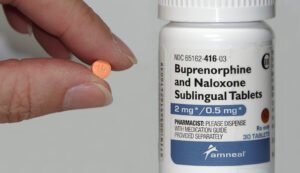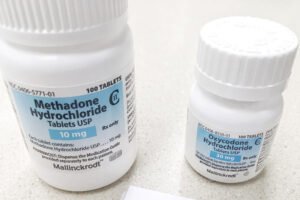Oxycodone, also known as OxyContin, Roxicodone or Percocet, is prescribed as a painkiller. The drug is part of the opiate analgesics class of medications. A doctor may prescribe oxycodone for moderate to severe pain, and it should only be taken as prescribed. Unfortunately, oxycodone is one of the most commonly abused prescription drugs. It can be abused if prescribed or taken for recreational use.
Oxycodone Addiction

An oxycodone use disorder can severely impact an individual’s life and health. From the negative side effects of oxycodone abuse to the consequences a drug use disorder has on a person’s career and social life, seeking treatment is crucial for managing an oxycodone addiction. Keep reading to learn more about oxycodone addiction, including symptoms and treatment options.
Is oxycontin addictive?
OxyContin, or oxycodone, is addictive. While the drug is intended to treat moderate to severe pain, it also produces a sense of euphoria when taken. Opioid receptors in the brain react to the drug, activating the brain’s reward center. This cycle can make a person want to take more oxycodone to continue experiencing the euphoric feeling.
Over time, a person can develop a tolerance to oxycodone. More of the drug is required to feel relief from pain or the same high that a lower dose once provided. Oxycodone abuse and dependence can transition into addiction when the drug is prioritized above responsibilities or other activities, and an individual continues to use the drug despite negative consequences.
Is oxycodone physically addictive?
Oxycodone is physically addictive, and people can develop a tolerance to the drug over time. Taking oxycodone directly impacts the brain, which can lead to a physical addiction. As the main ingredient in common painkillers for moderate to severe pain, individuals may start to abuse oxycodone for pain relief. When a tolerance is developed, it can take higher doses of the drug to experience relief from pain. Individuals may also try to replicate the sense of euphoria or high that oxycodone can cause, taking higher doses to experience the same effects.
Why is oxycodone addictive?
Oxycodone has many addictive properties, and it is not typically recommended for long-term use. The drug may be prescribed to treat pain from an injury, surgery, or cancer. While medical professionals consider the medication relatively safe when used in small doses as prescribed, the effects of the drug can lead to addiction.
The feeling of euphoria, a sense of relaxation, and pain relief are all pleasant to those who take oxycodone. In an effort to replicate the pleasant effects, people can start to abuse oxycodone. The mind-altering substance is difficult to quit once a dependency is developed.
How long does it take to get addicted to oxycodone?
Oxycodone is a Schedule II drug, having a high potential for abuse. It is difficult to determine who will or will not develop an addiction to oxycodone, and each individual is different. The rush of dopamine to the brain that occurs after taking oxycodone produces a pleasant or euphoric high, a sensation people may begin to crave. Even short term use of opioids, like oxycodone, can lead to addiction.
Is oxycodone addictive the first time?
Oxycodone is intended for use as a prescription painkiller. It is most commonly prescribed for a short-term pain relief, but dependence and addiction can develop quickly. Because each person experiences the effects of oxycodone differently, it is impossible to tell how quickly someone can develop an addiction to the drug.
Common risk factors for opioid addiction include:
- Unemployment
- Prior substance abuse
- Family history of substance abuse
- Contact with high-risk people
- Tobacco use
- Depression or anxiety
- Stress
- Prior rehabilitation for drugs or alcohol
Can you get addicted to 5mg oxycodone?
Oxycodone is available in tablets that contain 10mg, 20mg, 40mg, and 80mg. At one time, the highest available dosage was 160mg, however, it is no longer produced. Individuals who are prescribed lower doses of oxycodone for pain relief are still at risk of oxycodone addiction.
Prescribed doses are intended to be released into the body slowly. People who crush oxycodone pills and snort them or inject the drug attempt to bypass the time-release aspect of the drug.
How many people are addicted to oxycodone?
According to the American Society of Addiction Medicine, 20.5 million people in America, 12 or older, had a substance use disorder in 2015. Of the individuals who had a substance use disorder, 2 million involved prescription pain relievers. Women are more likely to be prescribed pain relievers in higher doses because they are more likely to have chronic pain.
From 2010 to 1999, prescription pain reliever overdose deaths increased more than 400% among women and 237% among men. As of 2020, the Addiction Center noted that more than 13 million Americans abuse oxycodone.
How do people get addicted to oxycodone?
An oxycodone addiction may begin innocently and with only good intentions. Oxycodone is the main ingredient for multiple prescription painkillers, including OxyContin and Percocet. It is commonly prescribed to treat moderate to severe pain, especially due to an injury, surgery, or cancer. Individuals may be prescribed oxycodone in small doses and for a short period of time. However, even prescription oxycodone use can lead to addiction.
A tolerance to the drug builds up over time as the brain and body adjust to the presence of oxycodone. More of the drug is required to experience pain relief or a sense of euphoria. Individuals can abuse oxycodone by taking a higher dosage than prescribed, using the drug recreationally, or snorting or injecting the drug.
A dependence on oxycodone occurs when an individual experiences withdrawal symptoms when they stop taking the drug. Higher doses are required to achieve a high, and they may begin to crave oxycodone. Individuals may not feel “normal” without oxycodone in their system.
When someone prioritizes the drug above everything else in their life, they may have an oxycodone addiction. An addiction can cause people to endanger themselves or others, struggle in their professional or social life, and continue using the drug despite negative consequences.
Oxycodone Addiction Symptoms
Despite being a prescription painkiller, oxycodone can be very dangerous. Abuse, dependence, and addiction can cause serious health risks and negative side effects, especially when combined with other drugs or alcohol. Oxycodone abuse can even be fatal in the event of an overdose.
Oxycodone abuse can cause a person to experience negative side effects, including:
- Dizziness
- Blurred vision
- Headaches
- Seizures
- Nausea
- Vomiting
- Depressed breathing rate
- Low blood pressure
- Dry mouth
- Loss of appetite
- Drowsiness
- Constipation
- Sweating
- Weakness
- Flushing
- Mood changes
Oxycodone abuse for an extended period of time can lead to even more serious health complications. Heart failure, insomnia, depression, swelling in limbs, coma, and even death are possible if someone continues to abuse oxycodone.
Oxycodone Addiction Signs
For many people, oxycodone abuse is as simple as taking a pill. Individuals may even have a prescription for the medication, and there is no obvious drug paraphernalia associated with oxycodone abuse and addiction. For these reasons, it may be difficult to identify and address an oxycodone use disorder.
Recognizing the outward signs of a potential oxycodone addiction can help people seek treatment sooner. The following symptoms may indicate oxycodone addiction.
- Using the drug in ways that are dangerous to the individual or others
- Relationship problems due to oxycodone use
- Failing to meet responsibilities, including work, school, or home
- Withdrawal symptoms when an individual stops using oxycodone
- More oxycodone is required to achieve the same effect
- Increased amounts of oxycodone are used for longer periods of time
- An individual tries to cut back or stop using oxycodone but cannot
- Considerable time is spent seeking, using, and recovering from oxycodone
- Activities an individual once enjoyed are skipped in order to use oxycodone
- An individual craves oxycodone
If an oxycodone addiction or use disorder is suspected, it is important to seek medical treatment right away. A doctor can properly diagnose an oxycodone addiction and provide recommendations for safe and effective treatment.
Oxycodone Addiction Treatment
Oxycodone addiction can be deadly. An intervention may be an important first step if you suspect that a loved one has an oxycodone use disorder. You can organize the intervention yourself or reach out to an intervention specialist for help.
Once an individual recognizes that they have an oxycodone use disorder or addiction, they should seek medical help. Oxycodone withdrawal symptoms can be very uncomfortable and potentially dangerous. There are various oxycodone addiction treatment options available for a safe recovery.
Best Treatment for Oxycodone Addiction
Inpatient rehabilitation centers provide the medical supervision and support needed to face oxycodone withdrawal and recovery. Therapy and support groups are available to help a person continue on their recovery journey and address potential triggers for oxycodone use. There are even Medication-Assisted Treatment options that can help mitigate withdrawal symptoms and reduce cravings to support long-term recovery.
Is hydrocodone more addictive than oxycodone?
Both hydrocodone and oxycodone are opioids. The painkillers block pain signals in the body and may be prescribed to treat severe pain. Using either drug for a long period of time can lead to addiction or abuse. Oxycodone tends to be more expensive than hydrocode, and it may produce fewer side effects. However, the high from oxycodone has been described as more intense and pleasurable than hydrocodone.
Is methadone more addictive than oxycodone?
Methadone is often used to treat opioid addiction and it is much stronger than morphine. The drug is dispensed in outpatient clinics or opioid recovery treatment facilities to provide long-term maintenance for opioid recovery. While oxycodone is stronger than morphine, it falls slightly under methadone.
Heroin vs Oxycodone Addiction
Oxycodone is an opioid, and the effects of the drug are similar to heroin. Common effects of oxycodone use are relaxation, confidence, euphoria, calmness, and happiness. Because oxycodone is a prescription drug, it may be easier for some individuals to access than heroin.
However, oxycodone addiction treatment does not carry quite the same stigma and judgement as heroin addiction. For this reason, individuals may be more likely to seek help for an oxycodone use disorder. Unfortunately, abusing either drug is very dangerous, and oxycodone addiction can lead to heroin use.
Oxycodone Withdrawal

Opioids, like oxycodone, are very powerful painkillers. However, as part of the Schedule II drug class, oxycodone carries a high risk for potential addiction, dependence, and abuse. Even if oxycodone is prescribed by a doctor, it is still possible to develop an addiction. It is crucial that individuals take the medication exactly as it is prescribed by a doctor and speak to their physician immediately if they are concerned about the effects of oxycodone or developing an oxycodone use disorder.
Extended oxycodone abuse can greatly impact the body and brain. Over time, the body gets used to having oxycodone in its system. A person can develop a tolerance for the drug, and higher doses of oxycodone are required to achieve the same effects as before. Individuals can also abuse oxycodone in order to experience a feeling of euphoria, a high, or pain relief.
If an individual has a dependence on oxycodone or an addiction to the drug, it can be difficult to stop using the drug on their own. The addictive properties of oxycodone make the process harder, and withdrawal symptoms are uncomfortable. While oxycodone withdrawal is rarely considered life-threatening, it can make it more difficult to recover from an oxycodone use disorder.
Keep reading to learn more about oxycodone withdrawal, including symptoms of withdrawal, oxycodone withdrawal stages, and treatment options for oxycodone withdrawal.
Oxycodone Withdrawal Symptoms
When an individual stops using oxycodone or reduces the amount of opioid used, withdrawal symptoms can occur. Oxycodone impacts the brain, blocking pain signals and activating the brain’s reward center. As individuals seek the pleasurable side effects of oxycodone, they can develop a tolerance and more of the drug is required to achieve a high.
Some people do not feel “normal” without oxycodone in their system because their body has adapted to the drug. Removing oxycodone from the body after extended periods of use forces the body and brain to adapt once again.
Common symptoms of oxycodone withdrawal include:
- Nausea
- Vomiting
- Diarrhea
- Headaches
- Coughing
- Runny nose
- Teary eyes
- Sweating
- Muscle aches
- Shaking
- Body aches
- Increased heart rate
- High blood pressure
- Irregular heartbeat
- Insomnia
- Fatigue
- Depression
- Anxiety
- Irritability
- Agitation
- Difficulty concentrating
- Changes in mood
- Inability to feel pleasure
With consistent use of opioids, the brain’s chemical messaging is altered and it can struggle to function. When oxycodone is removed, the brain will struggle to find balance once again. This struggle often results in withdrawal symptoms because the central nervous system is disrupted.
What are the side effects of oxycodone withdrawal?
Oxycodone withdrawal can occur when an individual with an opioid use disorder or addiction stops taking the drug or reduces how much oxycodone is used. Side effects of oxycodone withdrawal are unpleasant, causing discomfort and even pain. Symptoms of withdrawal can include physical, psychological and emotional side effects. The chemicals responsible for positive emotions and pleasure are impacted by oxycodone use, and it takes some time for the brain to return to previous levels.
Drug cravings are common with oxycodone withdrawal, making it difficult to stay on the path of recovery. There is often a desire to start using the drug again in order to relieve withdrawal symptoms and side effects.
Emotionally, oxycodone withdrawal can cause irritability, agitation, and mood swings. Anxiety, depression, and suicidal thoughts are also possible side effects of oxycodone withdrawal. Individuals may find that they struggle to concentrate or feel like they are in a mental “fog.”
Physically, oxycodone withdrawal can make a person very uncomfortable or cause pain. Digestive issues like constipation, cramps, nausea, and vomiting are possible. Flu-like symptoms, including body aches, runny nose, coughing, and headaches are also common symptoms of oxycodone withdrawal.
Oxycodone Withdrawal & Depression
Mood changes are possible during drug withdrawal. Irritability and agitation can occur as well as anxiety and depression. Oxycodone affects the brain, altering the chemicals and reward center of the brain. During oxycodone withdrawal, it may be difficult for an individual to feel pleasure. The euphoria and high achieved by the drug is gone.
Individuals also struggle to come to terms with an oxycodone addiction during withdrawal. People may be upset about the time and money spent on an oxycodone use disorder. They are also likely to experience discomfort or a general sense of unease during oxycodone withdrawal.
Oxycodone Withdrawal & Diarrhea
Diarrhea and vomiting are also potential withdrawal symptoms of oxycodone. These symptoms can be painful or uncomfortable. More importantly, they can lead to dehydration. Losing electrolytes can make an individual even more uncomfortable during withdrawal, and dehydration can be serious if left untreated.
Oxycodone Withdrawal & Headache
Without oxycodone in their system, an individual may experience pain or sensitivity that was previously dulled by the drug. The brain is also adjusting to a lack of oxycodone, which can cause headaches throughout oxycodone withdrawal.
Oxycodone Withdrawal & Seizures
Seizures are possible with drug withdrawal, including oxycodone withdrawal. Withdrawal symptoms for oxycodone are rarely considered life-threatening, but it is still important to seek medical treatment in case seizures or other complications occur.
Oxycodone Withdrawal & Death
If properly supervised by a medical professional, oxycodone withdrawal is generally considered safe. However, the biggest danger occurs when a person goes through withdrawal and returns to the drug. Withdrawal can decrease an individual’s tolerance to oxycodone. If a person begins using the drug again at the same dose and frequency as before, they run the risk of overdose and death.
Oxycodone Withdrawal Timeline
Oxycodone withdrawal is different for everyone, and no two individuals will experience detox and withdrawal the same way. On average, oxycodone withdrawal lasts about a week. Physical symptoms typically peak within a few days after the last dose, and psychological symptoms of withdrawal can remain for several days.
How long does it take to start withdrawing from oxycodone?
Oxycodone withdrawal symptoms can begin within eight hours of the last dose. If an individual has used oxycodone for a long period of time, it is best to seek medical help instead of quitting “cold turkey.”
How long does oxycodone withdrawal last?
Symptoms of oxycodone withdrawal typically peak within the first 72 hours. Physical symptoms, like muscle aches, headaches, nausea, and vomiting can last for about a week before subsiding. Psychological effects of oxycodone abuse and withdrawal can continue after physical withdrawal symptoms are gone. Individuals may feel remorse for their actions while addicted to oxycodone, and it can be difficult to adjust to a new lifestyle and a lack of oxycodone in the body.
Oxycodone Withdrawal Day 1
The first day of oxycodone withdrawal is uncomfortable, and individuals may be more likely to relapse during this time. Symptoms of oxycodone withdrawal can begin 8-12 hours after the last dose. The most common symptoms on day one of withdrawal include headaches, nausea, fatigue, anxiety, irritability, cravings, and joint aches. Individuals may also experience flu-like symptoms such as a runny nose and sweating.
Oxycodone Withdrawal Days 3-5
Between three and five days, physical symptoms are at their worst. Nausea and vomiting may occur as well as shaking or cramps. Within a week, physical symptoms subside and psychological symptoms continue.
Oxycodone Withdrawal Duration
The duration of oxycodone withdrawal depends on a variety of factors. It is impossible to determine just how long withdrawal symptoms will last or how intense they will be. However, some factors may cause more intense symptoms. The formulation of oxycodone, the method it was taken, how long an individual has had a oxycodone use disorder, and previous drug rehabilitation can all impact how withdrawal affects someone.
Oxycodone Withdrawal Treatment
Quitting oxycodone cold turkey on your own can be dangerous. Oxycodone withdrawal symptoms can be severe, and a doctor can provide a medication withdrawal plan to mitigate the symptoms. Tapering your opioid usage reduces how much medication is taken on a gradual basis. This process can take weeks or months, but it is considered a safer way to stop using opioids.
Throughout a safe opioid taper, your doctor will prescribe a schedule to minimize any risks to your health. Your doctor can help monitor your blood pressure and pulse, check the medications in your system, provide pain therapies, or prescribe medication as needed to manage withdrawal symptoms.
An inpatient oxycodone withdrawal program can provide the medical supervision and comfortable environment to help make withdrawal smoother. You can also receive counseling services to learn coping strategies and identify triggers. Support groups and other therapies can help support recovery from oxycodone addiction as well.
Medication for Withdrawal from Oxycontin
There are multiple FDA-approved medications that can help with oxycodone withdrawal. A doctor may prescribe certain medications to shorten the timeline for withdrawal or mitigate the severity of withdrawal symptoms.
Suboxone for Oxycodone Withdrawal

Suboxone is used to treat an opioid addiction to help block opiate receptors and reduce cravings for oxycodone.
The prescription medication can also help reverse effects of oxycodone and other opioids.
Suboxone is sometimes prescribed at the beginning of oxycodone addiction treatment, and it is considered a preferred treatment method because methadone can be habit-forming.
Methadone for Oxycodone Withdrawal

In some cases, methadone can be prescribed during the withdrawal process. At tapered doses, methadone can help manage opioid withdrawal and reduce symptoms of withdrawal.
Methadone is administered under medical supervision.
Sources & Resources
Carise D, Dugosh KL, McLellan AT, Camilleri A, Woody GE, Lynch KG. Prescription OxyContin abuse among patients entering addiction treatment. Am J Psychiatry. 2007;164(11):1750-1756. doi:10.1176/appi.ajp.2007.07050252
Wakim JH. Alleviating symptoms of withdrawal from an opioid. Pain Ther. 2012;1(1):4. doi:10.1007/s40122-012-0004-5
NIDA. “FDA approves first medication to reduce opioid withdrawal symptoms.” National Institute on Drug Abuse, 16 May. 2018, https://www.drugabuse.gov/news-events/news-releases/2018/05/fda-approves-first-medication-to-reduce-opioid-withdrawal-symptoms Accessed 9 Sep. 2020.
Shah M, Huecker MR. Opioid Withdrawal. [Updated 2020 Jun 26]. In: StatPearls [Internet]. Treasure Island (FL): StatPearls Publishing; 2020 Jan-. Available from: https://www.ncbi.nlm.nih.gov/books/NBK526012/
